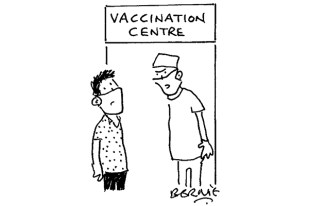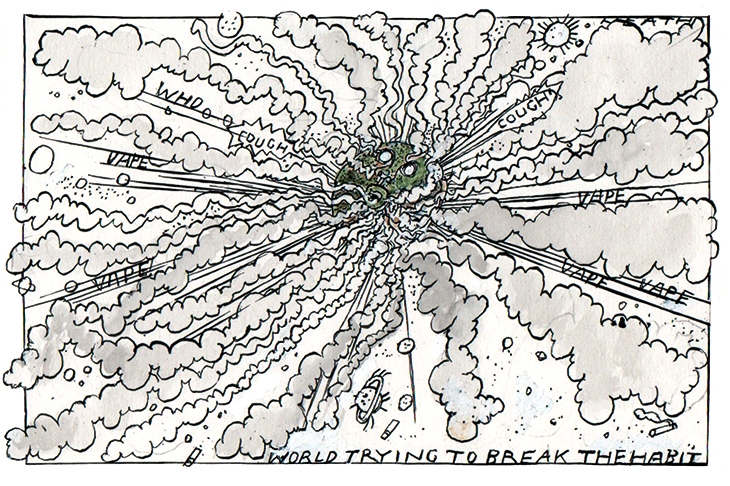When the COP26 climate change conference hits Glasgow at the end of October, the media will be out in force to discover how world leaders are going to meet their ambitious carbon emission targets. It will be on the front pages. Edited highlights will be on television. Boris Johnson and Nicola Sturgeon will be elbowing each other out of the way to get in the limelight. Extinction Rebellion will be performing their doomsday japes outside.
But when COP9 begins in November, few will notice. Admittedly, this event is being held online this year, but it would have flown under the radar even if it had been held in the Hague, as planned. It always does. Like COP26, it is a United Nations conference, but that is where the similarities end.
You probably haven’t even heard of it. Its full name is the World Health Organisation’s Framework Convention on Tobacco Control’s Ninth Conference of the Parties. The Framework Convention on Tobacco Control (FCTC) is the first and only international treaty of the WHO and COP is where it develops consensus statements and forges the path ahead.

For the WHO, the path leads not just to a tobacco-free future, but a nicotine-free future. This is not hyperbole — WHO Europe said it explicitly last year — and it is becoming a big problem for millions of vapers worldwide.
Around 3.6 million people in Britain vape. Most of them used to be cigarette smokers and no longer smoke tobacco at all. Public Health England and the Royal College of Physicians have both stated that the risks of vaping are at least 95 per cent lower than the risks of smoking. The US National Academies of Science Engineering and Mathematics concluded, after a thorough review of the evidence, that ‘e-cigarettes are likely to be far less harmful than combustible tobacco cigarettes’. The influential anti-smoking pressure group Action on Smoking and Health is supportive of vaping and says that ‘e–cigarettes have proved to be an important gateway out of smoking, not into it’.
These conferences might be funded by taxpayers, but the organisers treat them as strictly private affairs
The WHO, however, has been steadfastly opposed to e-cigarettes since they became popular a decade ago. The FCTC treaty explicitly defines ‘tobacco control’ as ‘a range of supply, demand and harm reduction strategies’ to reduce tobacco consumption, but it has never endorsed harm reduction in practice. At COP7 in India five years ago it called on member states to ‘prohibit or restrict the manufacture, importation, distribution, presentation, sale and use’ of e-cigarettes. Ideally, the WHO wants prohibition, but it will settle for excessive regulation to deter smokers from switching if a total ban is not politically feasible.
Despite growing evidence that e-cigarettes are the most effective stop-smoking method available and are nearly harmless, the WHO has doubled down on its opposition. Last year, as Covid-19 spread around the globe, it put out a series of bizarre tweets, falsely claiming that e-cigarette fluid burns skin and that second-hand vapour harms bystanders. One tweet even questioned whether e-cigarettes could be more dangerous than regular cigarettes. Almost unbelievably, it gave a special award to India’s health minister this year as a thank you present for banning the sale of e-cigarettes.
At COP9, the WHO wants to push countries towards treating vaping as harshly as tobacco, including large sin taxes and bans on e-cigarette flavours. Blinded by prohibitionist ideology, the FCTC’s secretariat are turning their guns on the very thing that is saving lives in Britain — and which could save millions more if rolled out worldwide.
For all its failings during the pandemic, the WHO is still respected in many quarters and sets the global health agenda. Low and middle-income countries often do not have the resources to carry out the kind of evidence reviews conducted in the UK and the USA. Instead, they rely on agencies such as the WHO and the FCTC, not knowing that they have been captured by a small group of abstinence-only prohibitionists. If the WHO says e-cigarettes are a dangerous product which threaten to derail decades of progress in the fight against smoking, many people will take it on trust.
The WHO has the most influence in developing nations which rely on it for assistance, but anybody looking for ammunition against vaping can argue from authority by quoting the agency. Both the European Commission and the EU’s Scientific Committee on Health, Environmental and Emerging Risks recently cited the WHO when assessing the evidence in preparation of the next Tobacco Products Directive. As the European Commission put it, the WHO ‘concluded that no firm evidence exists on the safety of e-cigarettes, but there is increasing evidence of harm’. Debatable at best, this is consistent with the WHO’s blinkered view of safer nicotine products. A WHO web page titled ‘E-cigarettes are harmful to health’ appears high in the search engine listings when people look for information about the health consequences of vaping. It says nothing positive about e-cigarettes and instead claims they are ‘undoubtedly harmful’ and ‘should be strictly regulated’.
There will be no politicians vying for attention at COP9. It is unlikely that any UK government ministers will be attending. Journalists and the public are technically allowed in as observers under strict conditions, but they are routinely thrown out on the first day. In 2014, a journalist from the Washington Times was physically ejected from the venue in Moscow after being told that ‘the media is banned’. The International Crime Police Organisation (Interpol) was denied entry on the basis that it had received money from a tobacco company to tackle black-market cigarette trafficking. In 2018, the internet livestream was cut off early in the proceedings. These conferences might be funded by taxpayers, but the organisers treat them as strictly private affairs.
It might be hidden from the eyes of the world, but a showdown between the pragmatists and prohibitionists beckons at COP9. With a delegation of its own now that it has left the EU, Britain has the opportunity to take a world-leading role in the promotion of science and good regulation. The British delegation is likely to include some ex-smokers who quit thanks to vaping and who will argue for the UK model of light-touch regulation and evidence-based messaging. If they succeed, our most successful post–Brexit export to date may not be a product, but a model that will save millions of lives.
However, if the WHO snubs Britain — which is the FCTC’s biggest funder — the organisation set up to improve global health could become one of its biggest threats.






Comments